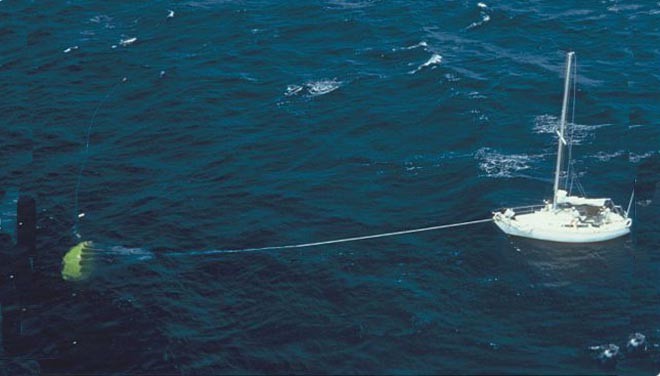Parachute sea anchor gets a ride into space
by Sail-World Cruising on 11 May 2013

Sea anchor deployed from the bow - not a recommended angle by Zack Smith SW
Popular parachute sea anchor used by many cruising sailors is to be used by NASA's new Orion spacecraft when it returns from its first beyond low Earth orbit flight test next year.
Gary Rohrkaste, United Space Alliance project manager for the Sea Anchor explained, 'Orion will always have a water landing and the Para-Anchor drag chute will be used on all capsule recoveries. The capsule has very little draft and wants to move right along the water. The parachute keeps the capsule from drifting too fast in the water and orients the large module for the rest of the recovery.'
Representatives of Houston-based United Space Alliance, subcontractor to Lockheed Martin on the Orion project, watched testing of the Fiorentino Para-Anchor in the harbor at Long Beach, California before they made the announcement.
Fiorentino's Zack Smith, well known researcher and lecturer on the USA Boat Show circuit, conducted the test involving load strengths and drag characteristics of a six-foot diameter parachute sea anchor, including accessory components of rope, bow shackle and snap shackle, towed by a crewed 100-foot vessel. The test was conducted principally to measure drag characteristics, including force and other critical elements, in evaluating the equipment for its ability to stabilize a space module upon sea impact.
At the end of Orion’s planned 2014 unmanned Exploration Flight Test 1 (EFT-1) mission, the 16.5-foot diameter, 18,000 lbs. crew module capsule is expected to splashdown in slight seas (Sea State 3).
Wulf von Eckroth, design engineer with United Space Alliance, noted that two Fiorentino chutes (one for actual use and one for back-up) will be used to stabilize the floating spacecraft crew module. The Fiorentino parachute anchor performed above the 150% requisite load test we required so the test was successful. '
The Orion spacecraft is America’s next human space flight system being developed with capabilities to take astronauts on long-duration, deep space missions beyond low Earth orbit to future destinations like asteroids, the moon and someday Mars. During the 2014 unmanned flight test, Orion will reach an altitude of 3,600 miles over the Earth’s surface, more than 15 times farther away than the International Space Station, and then return for a splashdown. NASA’s currently plans a second unmanned Orion mission in 2017 and a manned mission in 2021.
Zack Smith is a well-known drag device inventor and the head of Fiorentino’s Research and Design Team. Under his guidance, Fiorentino’s team conducted 15 years of sea trials on varying drag devices which resulted in innovative drag device designs and the pioneering 'Constant Rode Tension Theory.'
This theory states that keeping the rode taut through specific rode adjustment, weight placement next to the drag device, and the use of shorter bridles or Fiorentino’s unique free flying riding sail setup are the secrets of successful use of parachute sea anchors and storm drogues.
Smith worked previously with NASA on its Orion project in 2008 and received a NASA Team Achievement Award. He has also done numerous contract projects with the USCG, Navy, NAVSEA and SPAWAR. He recently produced 'The Complete Para-Anchor Set-up, Second Edition DVD which is available at http://www.para-anchor.com/index.html
Fiorentino Para-Anchor has been a leader in education and the development of parachute sea anchors and storm drogues for over fifty years (See http://www.sail-world.com/cruising/usa/Sea-anchor---do-you-know-how-to-use-yours-to-save-your-life?/93884!Sail-World_story). The company concentrates on advanced technical designs and quality materials unmatched in the industry to provide sailors with quality safety products.
If you want to link to this article then please use this URL: www.sail-world.com/109349

-728x90-202108170129.png)